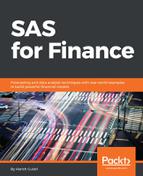One of the assumptions for ordinary least squares regression is that the error terms are independent. However, with time series data, much of the time, the error terms are correlated. This is also known as autocorrelation. The regression tests performed up until now don't test for autocorrelation. If autocorrelation is present in the model, then the parameter estimates may not be accurate, and the standard error estimates will be biased.
While the AUTOREG procedure should ideally be used for regressing time series data, we can still try to evaluate the model for autocorrelation by using PROC REG, which was used earlier. The statistic that is going to help us explore the autocorrelation is the Durbin-Watson (DW) statistic.
The PROC REG code for autocorrelation is as follows:
PROC REG DATA=build; ID date; MODEL basket_index eps p_e_ratio global_mkt_share media_analytics_index m1_money_supply_index top_10_gdp = /dw; RUN;
If the value of the DW statistic is close to 2, then the errors are uncorrelated. The highest level of the statistic observed was 0.256 for the variable basket index. However, in our model, there seems to be autocorrelation in all of the variables. We will ignore the following autocorrelation figures for now, and try to explore them in-depth when we discuss Auto-Regressive Integrated Moving Average (ARIMA):
|
Dependent |
Label 1 |
Value 1 |
|
Stock |
1st order autocorrelation |
0.993 |
|
Basket index |
1st order autocorrelation |
0.881 |
|
EPS |
1st order autocorrelation |
0.989 |
|
PE ratio |
1st order autocorrelation |
0.988 |
|
Global market share |
1st order autocorrelation |
0.988 |
|
Media analytics index |
1st order autocorrelation |
0.977 |
|
M1 money supply index |
1st order autocorrelation |
0.993 |
|
Top 10 GDP |
1st order autocorrelation |
0.995 |
